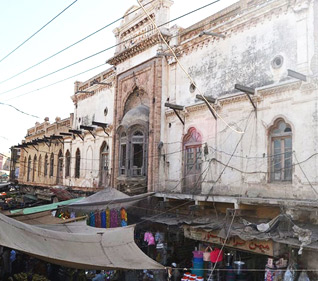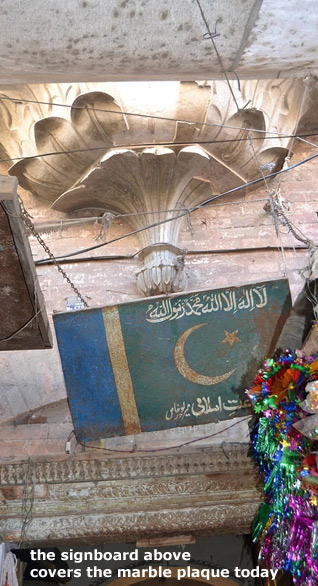Partition
Why Did Bhan Singh Break Down In Tears?
AKHTAR BALOUCH
To answer the above question, I will have to bring up the history of Bhan Singh's city, namely Mirpur Khas.
As the name suggests, Mirpur Khas was 'the special town of Mirs' in the old days. After the Partition of Punjab and the subcontinent, people who migrated to Mirpur Khas from the newly created India would be very particular about appending 'Sindh' to Mirpur Khas whenever they wrote to their relatives back in India and within Pakistan, emphasising that they lived in 'Mirpur Khas, Sindh'.
Similarly, people who migrated to Hyderabad would call their new home 'Hyderabad, Sindh'. This was an attempt on their part to prevent confusion as a town named Mirpur is located in Azad Kashmir, and a Hyderabad in India. They were afraid that their mail would be sent to Azad Kashmir's Mirpur or India's Hyderabad. This was not very likely but they still played it safe.
In Mirpur Khas, Bhan Singh -- a Sikh resident -- built a haveli (mansion) and a baithak (guesthouse), which was no less than a sprawling bungalow. In the backyard of the baithak stood a stable. Since he owned the entire estate surrounding his haveli and baithak, locals would refer to this quarter of Mirpur Khas as 'Bhan Singh Abad', which roughly translates into 'the town of Bhan Singh'.
There was a very small Sikh population in Mirpur Khas before the Partition but large enough to want to build their own place of worship here -- a Gadara -- in downtown Mirpur Khas.
It still exists, though it now houses the local offices of Jamaat-e-Islami and the Evacuee Trust Property Board (ETPB). A plaque on the facade of the Gurdwara has a few words inscribed in Gurmukhi script.
Recently, I was at the Karachi Press Club where the Chairman of ETPB Mr Siddiq-ul-Farooq was addressing a press conference. He declared that the government was planning to evict people for illegally occupying properties left by non-Muslims at the time of the Partition.
I had to stand up and ask, 'Would the government also return Mirpur Khas' Gadara -- where his department had set up its office -- to the Sikhs?' Mr Farooq said that since the Sikhs no longer lived in Mirpur Khas, it was difficult to decide as to who the custodian of the gurdwara should be.
He was right in that, after the Partition, Bhan Singh, along with the rest of the Sikh community in Mirpur Khas, had joined the exodus to India.
Back at Bhan Singh's haveli, I learnt he had lived on the upper story. His mansion was designed to house shops on the ground floor; these shops pierced into the walls of the haveli. Basically, he was a zamindar (landowner) and he had built these shops with the sole purpose of renting them out.
I couldn't help but marvel at the peculiarity of these 70-year-old old shops: Wooden foldable doors. Each door is divided into three foldable sections. The three sections are folded vertically, turning the door into a sun-shade when the shops open in the mornings, and turning it back into the door when they close in the evenings.
These shops with their innovative doors are still in use. Above them, you can see the remains of what was once a home. One of its outer walls holds proudly and high the skeleton of what may have been a turret clock. The hands of which have vanished with the ravages of time, but the dial has adamantly held on.
For this blog, I arrived in Mirpur Khas to draw a pictorial sketch of the gurdwara. Several shopkeepers were amused when I started taking pictures of the old building.
They asked in unison, 'When does the government plan to demolish this structure?' I told them that I was there only to learn more about the history of the place; they were disappointed.
Then, I entered the gate of the gurdwara and climbed a narrow stairway to arrive on the upper floor.
I found a man sleeping right outside Jamaat-e-Islami’s office. When I woke him up, he told me that the gatekeeper of the JI office had gone out. The party's signboard hung over a door, concealing the plaque of the gurdwara.
'How can I remove this JI signboard to take a snapshot of the concealed plaque?' I asked a man standing there.
'You'll need a stick,' he replied, bewildering me.
Then, he took a bamboo stick and pushed the JI signboard upwards. The plaque was now clearly visible for me to capture on my camera.
I had photographed the plaque, but it was impossible for me to read the Gurmukhi script. So I sent its picture to renowned critic, writer and translator, Ajmal Kamal for help. He forwarded the photographs to his friend Charanjeet Singh in Indian Punjab. Charanjeet transliterated the inscription as ‘Ek Onkaar Gur Parshad Punjabi Sikh Gurdwara Mirpur Khas’.
My quest to explore Bhan Singh Abad had left me wondering if Bhan Singh had ever returned to check on his estate?
I decided to find out by setting foot into Bhan Singh’s baithak, where he spent most of his time. Outside the bungalow, I met a man who introduced himself as Haji Rafiq. I asked him about Bhan Singh’s abode.
He pointed towards the house and said, “This house is now owned by Omar Rajput. It once belonged to Bhan Singh.”
I asked him if he had ever seen Bhan Singh.
He nodded in affirmation. “Yes, in 1964, when I was a seven-year-old boy. I remember a commotion in the streets, with residents shouting: ‘Bhan Singh is here’ as an old turbaned Sikh stepped out of the house and walked away. At the time, the house was owned by Advocate Alvi. Later, he sold it to Omar Rajput, who lives here now.”
Naturally, I knocked on the door.
Omar Rajput answered and upon telling him the purpose of my visit, he said, “Come in, son,” he said.
I took a few photographs and then asked Mr Rajput if Bhan Singh had ever returned.
“Yes, he did in 2004. Around 12 noon, someone knocked at the door. It is a fact that I am an old man now and living a retiree’s life. My sons and their children leave home early in the morning to go to their offices and schools. I am usually alone at home, so when there is a knock on the door, it takes me some time to answer it.
“When I opened the door, a very old man, in his 90s, was standing there with an old woman, whom he introduced as his daughter.
“The nonagenarian man asked, ‘Is this Bhan Singh’s house?'
“I said, ‘Yes, whom do you want to see?'
“And he said, ‘I am Bhan Singh. May I come in and see my house?’ I said, ‘Why not!' And took them in.
“I told my cook to make tea and arrange for some snacks as the original owners of the house had come.
“Then I just stood there as Bhan Singh and his daughter carefully touched the walls around them, gently stroking them. They kissed the window panes and held on to the doors as they quietly sobbed.
“At that point, I thought it best to leave them alone, so I told them that I'd be right back with tea.
“When I returned, they were both gone. I rushed out into the street after them, calling out ‘Bhan Singh, Bhan Singh’. But I was only met with a disquieting silence.”
The story stayed with me, like a warm memory, on my journey back to Karachi.
It was a few days after my return when I discovered, to my utter astonishment, that the area had been renamed to Orang Abad more than 10 years ago. I took some comfort in the thought that the signboards of all the small shops and the residents of Mirpur Khas had refused to let go of their ‘Bhan Singh Abad.’
Translated by Arif Anjum from the original in Urdu. Photos by Imran Sheikh
Akhtar Balouch is a senior journalist, writer and researcher. He is currently a council member of the HRCP. Sociology is his primary domain of expertise, on which he has published several books.
[Courtesy: Dawn. Edited for sikhchic.com]
January 12, 2016
Conversation about this article
1: Harpreet Singh (Delhi, India ), January 12, 2016, 2:45 PM.
Waheguru. Will the world ever know about the pain and suffering of innocent people killed, robbed, brutalized, or forced to flee their homes during the horrible days of the Partition of Punjab in 1947. Surely there must be some way that such people can travel freely to their ancestral places, and for free access to Sikhs to visit Nanakana Sahib, the holy birth place of Guru Nanak, and other historical places in Pakistan. Will it ever come about? Recently on the occasion of the birth celebrations of Guru Nanak, there was news about a Sikh-Canadian standing at the border and shouting as to why Sikhs can't visit Nankana Sahib.
2: Sangat Singh (Kuala Lumpur, Malaysia), January 12, 2016, 5:53 PM.
It must have been in the year 1945 when a boy of my age in knickers arrived to live within shouting distance on the street where we lived. I saw him and knew we would be good friends as he would surely join the only English medium school – Sacred Heart Convent School, Lyallpur. So it was and from then on we walked the mile to school together. He told me he was from Mirpur Khas, which sounded like ‘vilaayat’ (the term used in Punjabi for England then) to me. His family had some agricultural land in Mirpur Khas. His father, Capt. Satwant Singh, was busy fighting in World War II and decided on Lyallpur for schooling where they had an uncle who was a Prof. in Khalsa College. My friend Jugraj, now a retired Colonel, became my closest friend and remains so till this day. We share the same degree of deafness but do keep in touch at least by e-mail. I am sure he would love to talk tearfully about Mirpur Khas which is the same, yet not the same. Although there is new life yet, we are in the same world. For this we have to thank sikhchic.com.
3: Bhai Harbans Lal (Dallas, Texas, Texas), January 14, 2016, 1:16 PM.
Thank you, brother Akhtar Balouch Sahib, for bringing the story of Bhan Singh Abad to the world's attention. It is really sad. And there are numerous stories like this one on both sides of the Wagah border. All of this did not have to happen if our leadership was not so inept. I hope that we humans learn lessons from such tragedies.






